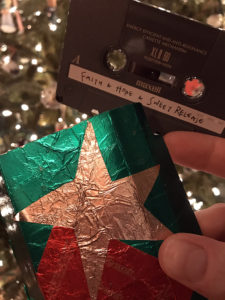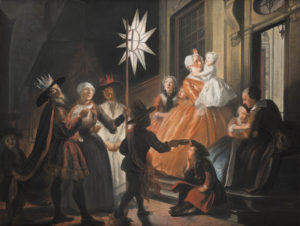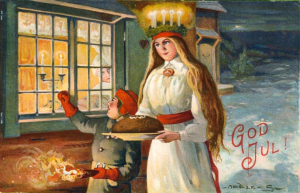TWELFTH DAY of CHRISTMAS:
Epiphany
I have always, since I can remember, been fascinated with the foil that is wrapped around chocolates. The process is always the same: I unwrap the chocolate, pop it in my mouth, and while I’m eating it, I take the foil wrapping and smooth it out with my fingertips against the table or any smooth surface I happen to be near. I like watching the foil transform from crinkled to smooth. Sometimes I save the smoothed-out foils. Sometimes I use them in projects, like the cover for the Christmas mixtape I recorded for Seth after I first met him, back in December of 1995. I miss mixtapes for many reasons… not the least of which is the artwork I’d get to do on the covers. A star of foil seemed just right for this tape that went to Seth and to a few other select friends I was missing that Christmas over 20 years ago.
The star is central to Christmas and to the journey of the Magi. As such, it is central to Epiphany, the celebration of this Twelfth Day of Christmas, which is traditionally considered the day the Magi arrived at the stable in Bethlehem. And with Epiphany, our Christmas celebration comes to a close. The Magi, those three old men, have traversed the desert, following that star, and they have arrived at the stable to bring gifts to the child. La befana, the kind Italian witch, has made her rounds, too. As the story goes, at that first Christmas oh so long ago, the Magi stopped at la befana’s house and asked her to join them on their journey, but she declined the invitation. “I have so much housework to do!” she told them. And so the Magi left her home and continued on their way.
But as she swept her floors, la befana began to feel a bit remorseful, and once she finished her sweeping, she set out to find the Magi. But she never did find them, nor the child they had told her about. She searched and searched but to no avail. Still, to this day, on each Twelfth Night, la befana sets out upon her broom to seek them. As she makes her rounds, searching high and low for the child and the three kings, la befana leaves small presents for all the sleeping children. And now, on Epiphany, she resumes her sweeping, and sweeps Christmas away for another year.
Tradition would have us remove all the Christmas greenery today. But if you are not yet ready to part with your tree or other decorations, we can offer you another older tradition to follow, for some would consider Christmas to last until the First of February, which is Candlemas Eve. There is some strong basis for this in the Pagan tradition, as it is on the First of February that Yule gives way to Imbolc in the wheel of the seasonal round: it is a cross-quarter day, the midway point between the winter solstice and the spring equinox.
In our home, we close the celebration of Christmas on Epiphany night with a simple ceremony at the front door, outside on the front porch. We will gather up all who are in the home and we will each take turns writing with chalk on the lintel above the front door the numbers and letters and symbols of a traditional inscription. This year, it will read as follows: 20+C+M+B+17. These are the initials of each of the Magi (C for Caspar, M for Melchior, B for Balthasar), punctuated by crosses, blanketed on either side by the year. For me, the inscribing is always accompanied by a silent prayer that no one will be missing when we gather next to write the inscription again. All the year through, though Christmas be gone, still the inscription is there to remind us of Christmas’s presence as we pass each day through that portal. The inscription is a magic charm of sorts, protecting the house and those who pass through that doorway, harboring the goodwill and spirit of Old Father Christmas.
And so we follow that star. May it always be in our sights and in our hearts and in our dealings with our fellow companions on this old earth. And one last time this year, we say unto you: “Merry Christmas.”
I called that 1995 mixtape “Faith & Hope & Sweet Release.” There was so much new and wonderful music that year: “Now it is Christmas Eve” from Garrison Keillor, “By the Fireside” from Turtle Island String Quartet, and an original song for Christmas by Jane Siberry whose lyrics lent the mixtape its title. Our old pick up truck has a cassette player and we still listen to that mixtape each Christmas. It never grows old.


